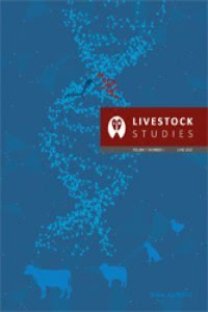ORTA ANADOLU MERİNOSLARINDA ÖNEMLİ VERİM ÖZELLİKLERİ VE SELEKSİYONLA GELİŞTİRİLMESİ İMKANLARI I. ÖNEMLİ VERİM ÖZELİKLERİ
Bu araştırma Konya Hayvancılık Merkez Araştırma Enstitüsünde yetiştirilen Orta Anadolu Merinoslarında önemli verim özelliklerinin düzeylerinin belirlenmesi, bazı çevre faktörlerinin bu özellikler üzerindeki etkilerinin incelenmesi, bazı verim özelliklerine ait fenotipik ve genetik parametrelerin hesaplanması, seleksiyon indeksi denkleminin kurulması ve böylece verimlerin seleksiyonla geliştirilmesi imkanlarının ortaya konması amacıyla yapılmıştır. Araştırmanın bu bölümünde ırkın çeşitli verim özellikleri bakımından genel verim düzeyleri incelenmiştir. Orta Anadolu Merinoslarında doğum oranı %80.80, ikiz doğuran koyun oranı %39.64 ve bir doğumda kuzu sayısı 1.40 olarak bulunmuştur. Kuzularda 30., 105. (sütten kesim) ve 180. günlerde yaşama gücü sırasıyla %91.77, 87.98 ve 85.89 olmuştur. Kuzularda doğum, sütten kesim ve 180. gün düzeltilmiş ortalama canlı ağırlıklar sırasıyla 4.65, 24.51 ve 37.10 kg bulunmuştur. Ana yaşı, doğum yılı, cinsiyet, doğum tipi ve doğum ağırlığının kuzularda büyümeye etkisi genelde değişik düzeylerde önemli (P<0.05, P<0.01, P<0.001) olmuştur. Araştırma sonucunda, Orta Anadolu Merinosu döl verimi, kuzularda büyüme ve koyunlarda yapağı özellikleri bakımından Türkiye’de ve diğer ülkelerde yetiştirilen et merinoslarına benzer veya daha yüksek, kuzularda yaşama gücü bakımından ise biraz daha düşük değerler göstermiş, döl verimi ve kuzularda büyüme kabiliyetinin iyi olması nedeniyle bu ırkın, kuzu eti üretiminin artırılması yönünde kullanılabileceği görülmüştür.
Anahtar Kelimeler:
Koyun, Merinos, döl verimi, yaşama gücü, büyüme, yapağı verimi
(Some Important Production Traits of Central Anatolian Merino Sheep and possibilities of improving through selection of these traits I. Important Production Traits)
This study was carried out to investigate the possibilities of improving through selection of the some important production traits in Central Anatolian Merino Sheep kept at Konya Central Animal Research Institute. For this purpose, the present performance levels and the effects of some measurable environmental factors on the some production traits have been determined and the phenotypic and genetic parameters of these traits have been estimated and also a selection index has been constructed. In this part of the study, performance levels for some important production traits have been considered. In the study, birth rate, twinning rate and litter size of ewes were found as 80.80%, 39.64% and 1.40, respectively. Of the lambs born live, 91.77% survived to 30 days, 87.98% to 105 days (weaning) and 85.89% to 180 days. The least squares means for lambs were 4.65 kg for birth weight, 24.51 kg for weaning weight and 37.10 kg for 180 days weight. The effects of the birth year, age of dam, sex, type of birth - rearing and birth weight of lamb on lamb weights at different ages were generally statistically significant (P<0.05, P<0.01, P<0.001). The least squares means of yerling females were 48.98 kg for body weight after shearing, 3.79 kg for greasy wool production, 22.37 µ for fiber diameter, 9.22 cm for fiber length and 12.11 crimps per inch; corresponding means for breeding ewes were 60.05 kg, 3.35 kg, 22.19 µ, 7.45 cm and 11.71 crimps per inch. The effects of the age of dams, year and sex on the some production traits and also the effects of the age of ewe, year and fertility status of ewe on the some production traits were generally significant (P<0.05, P<0.01, P<0.001). The results of the study showed that important production traits of Central Anatolian Merino sheep were satisfactory level, but survival rate of lambs was found lower than other Merino sheep breeds, and this breed can be used for lamb production
Keywords:
Sheep, Merino, fertility, survival rate, growth, wool production,
- Yayın Aralığı: Yılda 2 Sayı
- Başlangıç: 1959
- Yayıncı: Sezer ÖZ
Sayıdaki Diğer Makaleler
REPEAT BREEDER İNEKLERDE GnRH UYGULAMASI ve DÖL VERİMİ
SAKIZ X KIVIRCIK MELEZİ (F1) ERKEK KUZULARIN BESİ PERFORMANSI VE KARKAS ÖZELLİKLERİ
Halil AKÇAPINAR, Necmettin ÜNAL, Ceyhan ÖZBEYAZ
Necmettin ÜNAL, Halil AKÇAPINAR
FARKLI ŞEKİLLERDE İŞLENEN MAZIDAĞI FOSFAT KONSANTRESİNİN BROYLER RASYONLARINDA KULLANILMASI
Kemal KÜÇÜKERSAN, Ahmet ERGÜN, Seher KÜÇÜKERSAN, Ebru İMECE
AFYON İLİ SÜT SIĞIRCILIK İŞLETMELERİNİN GENEL ÖZELLİKLERİ İLE KARLILIK VE VERİMLİLİK ANALİZLERİ
Aytekin GÜNLÜ, Halit İMİK, Mustafa TEKERLİ
